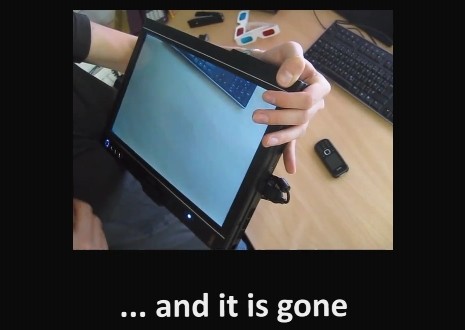Ever heard of diminished reality? It’s much like the augmented reality, except instead of using computers to add visuals, it’s about taking things out in real time.

That easy enough with a still image, perhaps, but not so simple with video… Technical University of Ilmenau’s figured it out, just draw a circle around the object you want to disappear and it practically disappears as the image synthesizer reduces the quality of the image drastically, removes your target and re-enhances in just 40 milliseconds per frame, using object tracking algorithms and guesswork to maintain the illusion as a camera moves around in 3D space. The framework’s presently running on Windows, but the team says they have plans to port it to Android soon.
read moreI spoke to Omar L. Gallaga from austin360 blog right before my SXSW panel
about emerging trends, including mobile, augmented reality, and social media, and he posted this interview on their blog; wanted to share a few PoV’s that I provided …
American-Statesman: As smartphones have gotten more popular, we’ve been hearing more and more about augmented reality. Can you explain to us what it actually is and how it’s being used?
Augmented Reality (AR) is the ability of combining digital and real-world aspects to provide a greater or enhanced experience. Traditionally, it’s layering a digital overlay on top of a video stream, think NFL first-down marker, or NASCAR car information. It is not new, but due to the recent penetration of web and mobile it has been getting greater buzz. It was originally coined in 1992, used in PCs in 1999, by Sony PS3 in 2007, but it wasn’t until 2009 when adopted by Flash and made available for the masses that it began to gain momentum.
NFL and NASCAR are basic examples of mainstream media using AR, but the true reach is when it’s more personal: enhance computer or phone video streams with digital layers triggered by either some market or symbol in the video, or GPS and compass information, or any data source that can be translated into personalized visualization that adds and provides value to the user. Traditional uses range from recognizing trading cards, to real-size mailing boxes, to visualizing how would your new TV look in your living room.
As smartphones have gotten more popular, mobile augmented reality still has not, but they’re setting the base bricks and platform to allow greater penetration in the future. Location awareness, compass, maps, user generated content, all contribute to greater and richer data sources that will allow for great digital and real world mashups. The best mobile apps right now are TwittARound, Layar, Nearest Tube, TAT Augmented ID, SREngine, and Wikitude AR Travel Guide.
read more